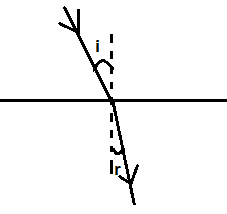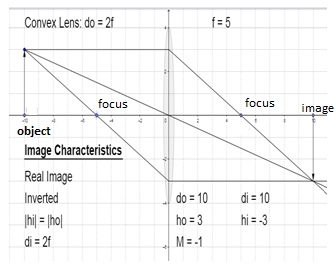
The image distance of an object placed
Answer
480.6k+ views
Hint: The relation between object distance, image distance and focal length is given by the lens formula. Substituting corresponding values in the lens formula and putting the correct sign for each by following the sign convention will give us the required value of image distance.
Formulas Used:
Complete answer:
Refraction is the bending of rays of light when it passes from one medium to the other. When light passes through a lens, it undergoes refraction.

Given- focal length is
By convention all distances in front of the lens are taken as positive and distances behind the lens are taken as negative. Therefore, image distance in a convex lens is positive but object distance is negative.
The Lens formula is given by-
Here,
Substituting the given values in eq (1), we have,
The image distance is

Here,
Note:
There are different image formations in a convex lens. It forms a virtual image if the object distance is \[u2f\] the image formed is diminished, real and inverted and formed beyond
Formulas Used:
Complete answer:
Refraction is the bending of rays of light when it passes from one medium to the other. When light passes through a lens, it undergoes refraction.

Given- focal length is
By convention all distances in front of the lens are taken as positive and distances behind the lens are taken as negative. Therefore, image distance in a convex lens is positive but object distance is negative.
The Lens formula is given by-
Here,
Substituting the given values in eq (1), we have,
The image distance is

Here,
Note:
There are different image formations in a convex lens. It forms a virtual image if the object distance is \[u
Recently Updated Pages
Master Class 9 General Knowledge: Engaging Questions & Answers for Success

Master Class 9 English: Engaging Questions & Answers for Success

Master Class 9 Science: Engaging Questions & Answers for Success

Master Class 9 Social Science: Engaging Questions & Answers for Success

Master Class 9 Maths: Engaging Questions & Answers for Success

Class 9 Question and Answer - Your Ultimate Solutions Guide

Trending doubts
Give 10 examples of unisexual and bisexual flowers

Draw a labelled sketch of the human eye class 12 physics CBSE

Differentiate between homogeneous and heterogeneous class 12 chemistry CBSE

Differentiate between insitu conservation and exsitu class 12 biology CBSE

What are the major means of transport Explain each class 12 social science CBSE

a Tabulate the differences in the characteristics of class 12 chemistry CBSE




